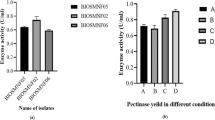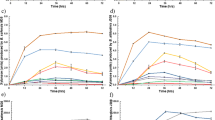Abstract
L-asparaginase production was optimized using isolated Bacillus circulans (MTCC 8574) under solid-state fermentation (SSF) using locally available agricultural waste materials. Among different agricultural materials (red gram husk, bengal gram husk, coconut, and groundnut cake), red gram husk gave the maximum enzyme production. A wide range of SSF parameters were optimized for maximize the production of L-asparaginase. Preliminary studies revealed that incubation temperature, moisture content, inoculum level, glucose, and L-asparagine play a vital role in enzyme yield. The interactive behavior of each of these parameters along with their significance on enzyme yield was analyzed using fractional factorial central composite design (FFCCD). The observed correlation coefficient (R 2) was 0.9714. Only L-asparagine and incubation temperature, were significant in linear and quadratic terms. L-asparaginase yield improved from 780 to 2,322 U/gds which is more than 300% using FFCCD as a means of optimizing conditions.


Similar content being viewed by others
References
El-Bessoumy, A. A., Sarhan, M., & Mansour, J. (2004). Journal of Biochemistry and Molecular Biology, 37, 387–393.
Mishra, A. (2006). Applied Biochemistry and Biotechnology, 135, 33–42. doi:10.1385/ABAB:135:1:33.
Mukherjee, J., Majumdar, S., & Scheper, T. (2000). Applied Microbiology and Biotechnology, 53, 180–184. doi:10.1007/s002530050006.
Mesas, J. M., Gil, J. A., & Martin, J. F. (1990). Journal of General Microbiology, 36, 515–519.
Raha, S. K., Roy, S. K., Dey, S. K., & Chakraborty, S. L. (1990). Biochemistry International, 21, 987–1000.
Manna, S., Sadhukhan, R., & Chakraborty, S. L. (1995). Current Microbiology, 30, 291–298. doi:10.1007/BF00295504.
Ramkrishnan, M. S., & Joseph, R. (1996). Canadian Journal of Microbiology, 42, 316–324.
Triantafillou, D. J., Georgatos, J. G., & Kyriakidis, D. A. (1998). Molecular and Cellular Biochemistry, 81, 43–51.
de Moura Sarquis, M. I., Oliveira, E. M. M., Santos, A. S., & da Costa, G. L. (2004). Memorias do Instituto Oswaldo Cruz, 99, 489–492.
Boeck, L. D., Squires, R. W., Wilson, M. W., & Ho, P. P. K. (1970). Applied Microbiology, 20, 964–969.
Narayana, K. J. P., Kumar, K. G., & Vijayalakshmi, M. (2008). Indian Journal of Microbiology, 48, 331–336. doi:10.1007/s12088-008-0018-1.
Mukherjee, P. S., Pandey, A., Selvakumar, P., Ashakumary, L., & Gurusamy, P. (1998). Journal of Scientific and Industrial Research, 57, 583–586.
Mishra, A., & Das, M. D. (2002). Applied Biochemistry and Biotechnology, 102, 193–199. doi:10.1385/ABAB:102-103:1-6:193.
Abdel-Fattah, Y. R., & Olama, Z. A. (2002). Process Biochemistry, 38, 115–122. doi:10.1016/S0032-9592(02)00067-5.
Prakasham, R. S., Subba Rao, Ch., & Sarma, P. N. (2006). Bioresource Technology, 97, 1449–1454. doi:10.1016/j.biortech.2005.07.015.
Wriston, J. C., & Yellin, T. O. (1973). Advances in Enzymology, 39, 185–248.
Sukumaran, C. P., Singh, D. V., & Mahadevan, P. R. (1979). Journal of Biosciences, 1, 263–269. doi:10.1007/BF02716875.
Box, G. E. P., Hunter, W. G., & Hunter, J. S. (1978). In Statistics for experimenters (pp. 291–334). New York: Wiley.
Cochran, W. G., & Cox, G. M. (1957). In Experimental design, 2nd ed (pp. 346–354). New York: Wiley.
Sreenivas Rao, R., Prakasham, R. S., Prasad, K. K., Rajesham, S., Sarma, P. N., & Rao, L. V. (2004). Process Biochemistry, 39, 951–956. doi:10.1016/S0032-9592(03)00207-3.
Subba Rao, Ch., Sathish, T., Laxmi, M. M., Laxmi, G. S., Rao, R. S., & Prakasham, R. S. (2008). Journal of Applied Microbiology, 104, 889–898. doi:10.1111/j.1365-2672.2007.03605.x.
Prakasham, R. S., Subba Rao, Ch., Rao, S., & Sarma, P. N. (2007). Journal of Applied Microbiology, 102, 204–211. doi:10.1111/j.1365-2672.2006.03058.x.
Prakasham, R. S., Subba Rao, Ch., Rao, R. S., & Sarma, P. N. (2007). Journal of Applied Microbiology, 102, 1382–1391. doi:10.1111/j.1365-2672.2006.03173.x.
Acknowledgements
M. Hymavathi is thankful for University Grants Commission and T. Sathish and Ch. Subba Rao are thankful for Council of Scientific and Industrial Research, New Delhi for financial support in the form of Senior Research Fellowship.
Author information
Authors and Affiliations
Corresponding author
Rights and permissions
About this article
Cite this article
Hymavathi, M., Sathish, T., Rao, C.S. et al. Enhancement of L-Asparaginase Production by Isolated Bacillus circulans (MTCC 8574) Using Response Surface Methodology. Appl Biochem Biotechnol 159, 191–198 (2009). https://doi.org/10.1007/s12010-008-8438-2
Received:
Accepted:
Published:
Issue Date:
DOI: https://doi.org/10.1007/s12010-008-8438-2




